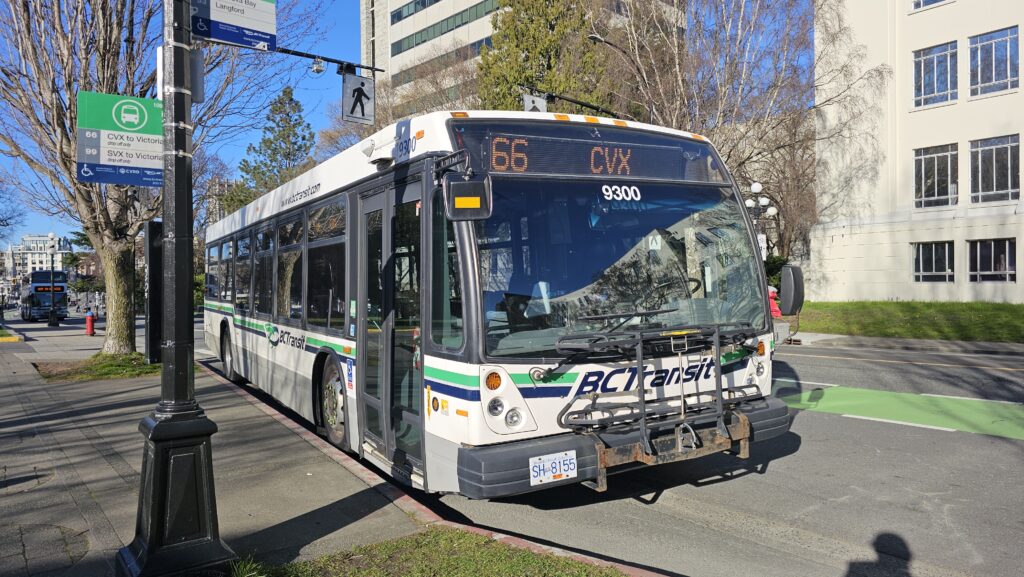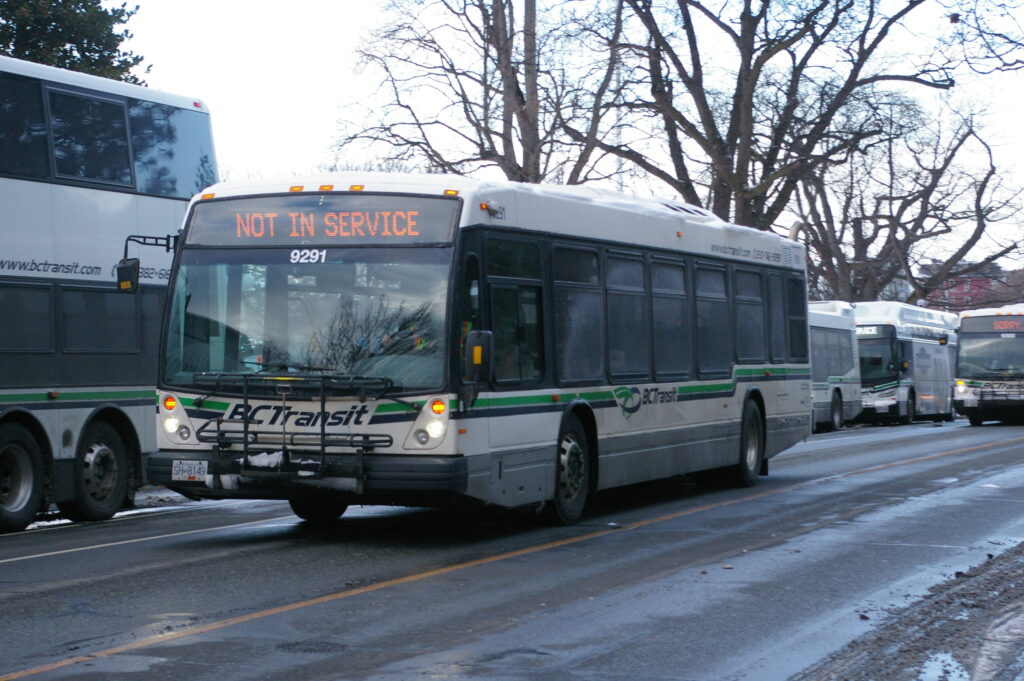At the time of writing, there is no bus service in BC Transit’s Cowichan Valley Regional Transit System (read: Duncan, Lake Cowichan, etc.) due to an ongoing strike.
In fact, there hasn’t been any bus service there since February 8 of this year, and we’re well into August now—that’s 197 days and counting.
It’s a real problem.
The worst part of it all is that, at this point, it has become difficult to claim that this is only an isolated case.
This strike is part of an emerging pattern at BC Transit, where we have seen major strikes resulting in complete system shutdowns in 2022, 2023, and now, 2025. Each of these has lasted more than four months, causing widespread disruption in their respective communities.
We will continue to feel the repercussions of these outages for years to come—and this all begs the question, what can be done to avoid these shutdowns? What responsibility does BC Transit (and therefore the province) have in creating or permitting this mess?
I wish to discuss the impacts that these strikes are having, and provide some background about how BC Transit’s systems are run and managed. What I won’t get into are the substantive issues in the labour disputes themselves, and perhaps disappointingly, I can’t in good faith offer any sort of silver-bullet quick-fix solution.
The issues here are complicated and interconnected, which, sadly, is the usual case.
What is clear is that the shutdowns that result from these strikes cause severe, counterproductive, and completely unacceptable consequences for the communities impacted.
Long term impacts
Imagine being someone dependent on transit, as many are in the Cowichan Valley Regional District (home to around 90,000 residents): it’s one thing to have to change your plans because the bus isn’t going to be available for a few days, but now it’s been nearly half a year. Hopefully you have family or friends who are able to help you from time to time, but gone is your independence.
Now, imagine being someone who has the option of driving. If you had a way to obtain access to a car, surely you would have done so by now; who among us can put their life on hold for five or more months to wait for labour issues to get resolved so that they can take transit once more?
And once this is all over, could you trust BC Transit to get you where you need to be in the future?
Across the transit advocacy cinematic universe, there is constant talk about encouraging “modal shift” away from cars and toward public transit—or even better, toward sustainable modes of transportation such as walking or cycling.
There are countless arguments for the societal and individual benefits of reducing car dependency as much as possible, and I would count myself among those who believe it’s a noble cause to advocate for.
But for those living in Cowichan Valley, you can’t deny that this is an enormous, magnificent, inescapable lesson against living car-free. The service outage is disastrous, and it sends the message to those living in the area that transit is an optional luxury, that is inessential, and that the government expects you to have alternative plans you can use for any length of time.
In a broader sense, with outages like this, we are training a generation of potential transit users to share that car-first mindset. It has long been established that one way to build ridership is to encourage youth to get used to riding the bus, and then provide a reliable service that they may continue to benefit from and use into adulthood. The BC government already does this with programs like the GradPass (free transit for recent high school graduates) and the U-Pass (a discounted transit pass program for university students).
Now, having said all of that, Cowichan Valley is but one of many transit systems in our province.
There are over 50, ranging in size from huge networks serving our major cities to tiny one-vehicle networks like 100 Mile House. With the notable exception of TransLink in Metro Vancouver, each one is managed by BC Transit (more on that later).
Cowichan Valley’s system is decidedly a separate beast from the large transit systems serving the much denser urban regions of Metro Vancouver or Greater Victoria. While this strike is already a remarkable event, it might still seem unimaginable that it could happen to a “bigger” system.
You might imagine that a major strike would immediately cause “real problems” in those cities. Instead of merely impacting the transit dependent population, there would surely be traffic chaos and severe economic impacts, so a long term shutdown couldn’t happen in a big city, right?
Unfortunately, the situation in Cowichan Valley is not isolated. In fact, it is part of a very concerning trend among BC Transit systems—and not just the small ones.
Part of a pattern
The current strike is the longest in BC’s history, breaking the record set in 2022 when Whistler had a 137 day strike from January 29 to June 15.
While Whistler isn’t a huge town by population, it is a gargantuan tourist destination year-round and has a robust bus network, with service levels and ridership much higher than its peers. As the weeks turned into months, the strike received national media attention for the impacts it caused.
It seemed insane to me that our system of governance would tolerate a complete outage of this length; I imagined that changes would be made in its wake.
But then it happened again in 2023, when the Fraser Valley system shut down for 124 days from March 20 to July 21. This is particularly crazy since the Fraser Valley isn’t some small town. Rather, it is a region of 324,000 people as of the 2021 census, and growing at an incredible rate. To put that in perspective, the region has more residents than Kelowna, and isn’t too far behind Greater Victoria.
We have also been very close to having shutdowns happen to huge systems, like TransLink in Metro Vancouver, only for deals to be struck at the 11th hour (sometimes literally).
Although long ago now, it would be remiss if I didn’t mention the 123 day strike Vancouver suffered in 2001 which involved 3,500 workers and 1,100 buses. Vancouver is now a significantly larger city, and TransLink is nearly twice as big—but that episode still looms large.
In 2001, people got mad. There were protests at the art gallery, manure was left at the head of TransLink’s house, standard stuff.
So in the case of Cowichan Valley then, toward whom should we get mad?

Playing the blame game
Clearly, there’s lots of frustration to go around, and the first place you’d want to point your finger is at BC Transit’s administration.
Naturally so.
But they would be quick to tell you that it is not their problem since they don’t operate transit service in the Cowichan Valley, nor Whistler, nor the Fraser Valley.
I wouldn’t blame you for being deeply confused here. Why does it say “BC Transit” on the side of the bus, and at every stop, and on everything else?
Well, BC Transit is a unique and complicated corporation. The short answer is that most of BC Transit’s systems have their operations contracted out to a private firm. This firm is then responsible for supplying drivers and maintenance personnel, as well as operating and maintaining the buses.
It is with these contractors that the unions representing employees bargain, so in a direct sense, it’s true: BC Transit cannot dictate the actions of these private firms that are doing the bargaining. At least, not until their operator contract is up for renewal.
For Cowichan, the operator is Transdev, a large multinational transit operations company based in France. In the case of Fraser Valley, it was First Transit, a large American firm (which has since been bought out by Transdev). Transit in Whistler is operated by the somewhat more local PW Transit, who have operations across Canada.
Despite this, planning, funding and the bus fleet itself are managed centrally by BC Transit. So too are the customer facing aspects like branding, the website, and rider information.
There are certainly benefits to this. BC Transit negotiates a separate operating deal for each system it runs, and it shares the responsibility for funding each one with the relevant local governments.
This means that small and medium sized communities in BC often enjoy more (and higher quality) transit service than they would be able to manage otherwise.
However, it is clear that BC Transit cannot absolve itself of all blame. After all, BC Transit remains responsible for the operation of its systems, and BC Transit selects and manages its contractors.
I would argue that not running any buses is not a good way to operate a bus service… so evidently BC Transit’s chosen contractors are not performing very well.
So, with regard to the ongoing strike… can we blame these private contractors?
Sure, although I’m not sure this is very productive.
They’re profit seeking entities who have an interest in paying their employees as little as is feasible. After all, we hired them to provide service as affordably as possible. These companies are large enough that the impacts of having a protracted strike probably aren’t such a big concern.
…can we blame the unions who are on strike?
Again, I don’t wish to wade into the specifics of the negotiations, but it is the prerogative of the union and its members to pursue bargaining with the employer—including strikes—subject to the province’s labour laws. Their concerns are their own, and I will suggest that they are often reasonable. Our transit workers deserve a living wage, no doubt there.
I would also suggest that it seems remarkable that the labour concerns of about 50 employees (in the case of Cowichan Valley) are able to shut down an entire region’s transit for half of a year.
So perhaps we must blame this contract model that BC Transit has.
However, BC Transit is far from the only agency that contracts out service like this. It’s standard practice across the industry. Transdev alone operates buses in Phoenix, LRT in Edmonton, trams in Barcelona, trains in Germany, BRT in Colombia, and ferries in Sydney. Similar groups are present just about everywhere else on Earth.
It remains the case that contracting out operations is cheaper than running things in-house, which BC Transit currently does for the Victoria Regional Transit System—easily their largest system by most metrics. In other cases, municipalities are contracted to operate the system themselves, like in Nanaimo or Nelson.
Something’s gotta change
It’s clear that something is wrong with BC Transit’s contracting model.
It’s easy to suggest that BC Transit should simply move most operations in-house and all would be well. After all, BC Transit is a crown corporation, which means it is a creature of the provincial government, and the province has the power to order it to do what it wishes.
If BC Transit, and therefore the province, is keen to have more control in these labour disputes and wants to avoid protracted strikes, having everything in house would make this easier.
However, this would come at a price. In-house operation will cost more, and the increased cost would likely lead to service cuts among all the contracted systems. Municipalities would be paying the same money for less service, and nobody would be happy about that.
I guess, as so many things do, it comes down to BC Transit being broke. Public transit very rarely makes a profit, and especially for smaller communities, we can’t ever expect it to come close. So really, it comes down to how much operating funding the province is willing to budget.
Even in Victoria, BC Transit is unable to keep up with running the service levels the region needs. Much of that is due to population growth and worsening traffic delays, but also higher operating costs – including labor.
The province has been supplying some money to keep the lights on, but not nearly enough. Even though BC Transit is paying for more service hours in Victoria than they were pre-pandemic, actual service levels are stagnant if not worse.
Of course, Victoria’s ridership has since recovered. Provincewide, ridership is as higher than it has ever been.
My impression is that TransLink has been luckier when it comes to funding than BC Transit as of late, but there is still that impending budgetary “fiscal cliff”, where if we don’t restructure how funding works for TransLink, we’ll be walking into devastating service cuts that are tantamount to a complete demolition of the system. But that’s for another article – just ask SEPTA in Philadelphia (and so many others across the US and Canada).
So beyond simply investing in significant new transit funding to mitigate the impacts of stepping away from the contract model of today, what other options do we have to avoid these big shutdowns?
Well, we could change the law to forbid strikes like this from going on so long, possibly by designating transit as an essential service.
After all, it was back-to-work legislation that ended the long TransLink strike of 2001.
Maybe the legislation could be targeted such that only an essential skeleton service is maintained during job action, to alleviate impacts on the most needful who would suffer the most.
That wouldn’t address the core problems at hand, though, and I imagine it would be pretty unpopular with workers. Not a great outcome, by any means.
I don’t believe there is a silver-bullet policy change that would resolve this immediately.

Conclusion
Our government—at the time of writing, an NDP government under premier Eby, is one that has claimed to include transit investment as one of its key goals. In the most recent election campaign, the NDP even suggested that improving regional connections is a priority.
The provincial government has many competing priorities for its pot of money, and the legislature has many competing priorities for its attention. I can’t claim that transit is the biggest crisis that the province currently faces, but it’s no doubt an important issue that must be addressed.
I don’t wish to suggest that they have totally abandoned their promise, but in practice, we have seen the very opposite! One of BC’s few successful and practical regional connector routes (the 66 CVX, which provides a connection from Victoria to Nanaimo) has been shut down for most of the time since our current government has been re-elected.
In my opinion, the government’s track record on transit issues has been decent but certainly not stellar. I believe, however, that like any government, they can and will respond to pressure from advocates and customers. We are their constituents.
Now, I’m not necessarily suggesting leaving piles of manure on the doorstep of the transport minister, but there’s other actions you can take that don’t require getting so dirty. Tell your friends and family. Spread awareness about the plight of Cowichan Valley, and all the other systems that have suffered through this.
As the co-administrator of bctracker.ca, a site for browsing BC Transit schedules and real-time bus tracking, I have not relished having needed to put up a banner that effectively says “There are no buses to ride, and there is no end in sight.”
I didn’t like having to do it the first time, but I never expected having to do so on three separate occasions, for months at a time.
All I can say is that this just isn’t good enough. If we, as a province, truly believe that providing alternatives to car dependency is important, then something’s gotta give.


Leave a Reply